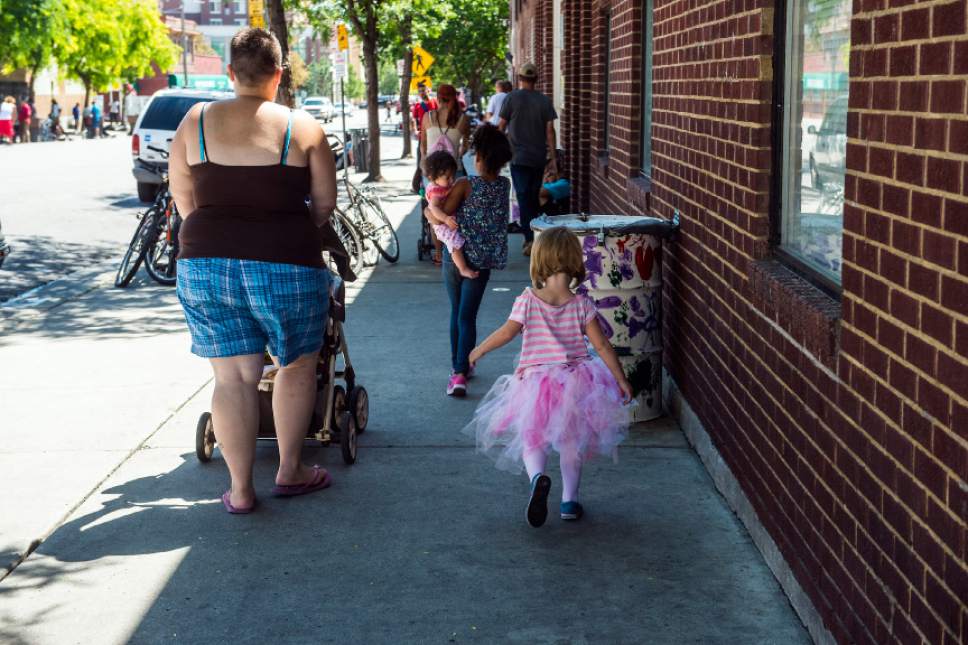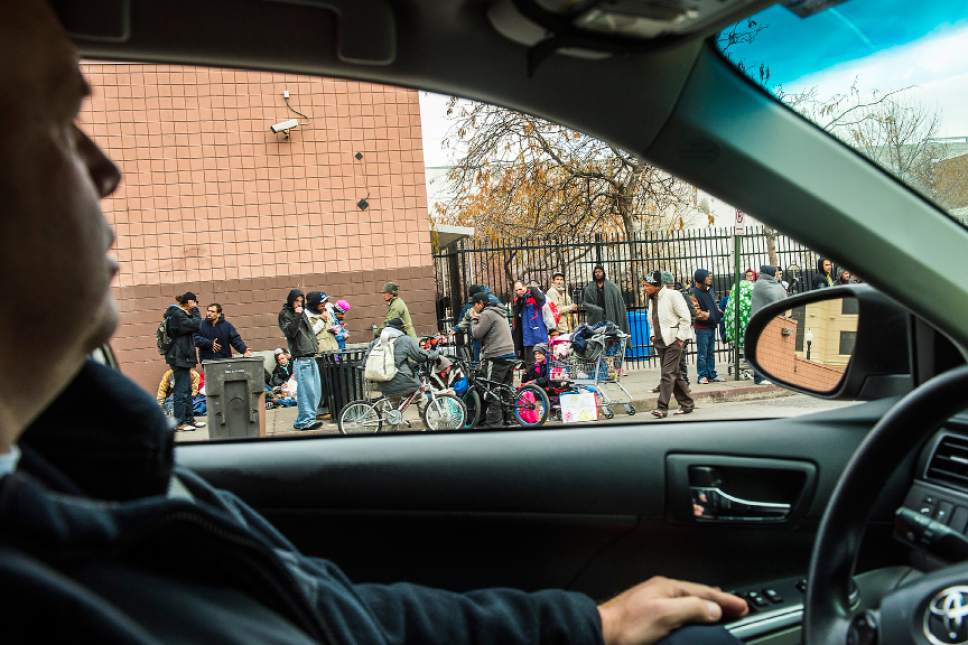This is an archived article that was published on sltrib.com in 2017, and information in the article may be outdated. It is provided only for personal research purposes and may not be reprinted.
Five-foot-tall chain-link fences will soon stretch down 200 South in Salt Lake City, creating a barrier between the downtown homeless shelter and The Gateway mall.
The project was requested by the mall's owner, Vestar, for "safety and security needs." It would close the mid-block pedestrian crossing of 200 South along Rio Grande Street — which connects The Road Home shelter and the mall — directing people to cross instead at the lighted intersections at 400 West or 500 West, either end of the block-long planned fencing.
Two chain-link fences, bordering each side of the TRAX line near the Old GreekTown Station, would be paid for by the Utah Transit Authority (UTA), according to emails exchanged between city officials and Gateway employees. The correspondence was obtained by KUTV-Ch. 2 through open-records requests and shared with The Salt Lake Tribune.
Remi Barron, UTA spokesman, said because the property belongs to his agency, "we have to construct the fence." He estimates the project will cost roughly $42,000, though the emails put the bill as high as $54,000.
"The city requested that this be done," he said. "We did our own look at it and decided it was a safety hazard."
Barron called 200 South "probably our number one traffic corridor" for buses and the rail line. Additionally, a large number of people hang around the area near the shelter, overflowing onto the sidewalks. Those individuals, Barron said, often jaywalk across the street, despite the mid-block crosswalk, and stroll along the tracks, causing "multiple reported" near-misses by cars and TRAX trains. The fence, he said, is intended to reduce the risk of an accident.
The emails describe the fencing as "black vinyl," seeming to suggest an opaque barrier between the shelter and the mall. Barron assured it would be "see-through" with the typical golf-ball-size holes of chain-link fences. The vinyl, he added, is wrapped tightly around the metal links because "there's electricity flowing through the area."
Salt Lake City will also pay "minimal costs, a few thousand dollars" to remove striping and signs along the street, said city spokesman Matthew Rojas. The emails indicated that could be as much as $15,000.
Rojas pointed to other similar fences near the downtown library and the University of Utah football stadium, both near TRAX lines, that are meant to block pedestrians from crossing the rails. He referred to the structures as a "safety fence" and said the one along 200 South is not meant to shut off access for homeless individuals to the mall.
"It's not about closing off the shelter from Gateway," he said. "People can go a half a block to the east or a half a block west that has a protected light."
Barron said he anticipates the fence will be constructed "within the month."
UTA also said the project wasn't aimed at limiting movement among the homeless population — "that wasn't our thought process," said Barron. Still, the emails suggest the jaywalking problem will be cleared up when The Road Home is shut down in June 2019 as the city opens two new shelters at 131 E. 700 South and 275 W. High Ave. and the county builds a third at a site still to be determined.
"When conditions in the area change as new resource centers come online in other parts of the city, it might be possible to review this decision," wrote Mike Reberg, director of the city's Department of Community and Neighborhoods in a message dated Oct. 6. Reberg could not be reached for comment Friday.
Nowhere in the exchanges are the words "homeless" or "shelter" used.
In a comment to The Tribune, Matt Minkevitch, executive director of The Road Home, also did not mention how the fencing might impact those who stay at the shelter. He said only that he hopes "the proposed fence will provide greater safety for pedestrians."
City Councilman Derek Kitchen cautiously criticized the plan to close the mid-block crosswalk, which he says goes against city planning goals. He would rather see fencing that steers people to use the designated crossing, such as near City Creek mall. He also worries about potential discrimination.
"I just want to make sure that we've got all of our ducks in a row because if we're closing a crosswalk to prevent a certain group of people from using the crosswalk," he said, "we have to just ensure that we are moving forward with the best planning practices and equity and fairness in mind as well."
Kitchen emailed city administration Friday seeking data "showing this [current setup] is unsafe."
Jenny Cushing, vice president of leasing for Vestar, which bought The Gateway in February 2016 and has pledged a $100 million investment to revitalize the mall, issued a statement Friday about the "dangerous conditions" along 200 South.
"This is an important issue surrounding public safety, and we want to be the best community partner we can be," she said. "It's our job to be diligent in ensuring the safety of our patrons, employees and residents — that's our top priority."
In the released emails dating back to October 2016, Cushing pushes several times for a concrete date for moving the project forward. "Just following up on this? Any timeframe on approvals you can provide?" she asked on Oct. 17. "Hello all, following up on this? What is the status?" she wrote on Nov. 30. And again on Feb. 1: "Can you please provide an update on where we are with this?"
Editor's note: The Salt Lake Tribune is located at The Gateway.
Twitter: @CourtneyLTanner





